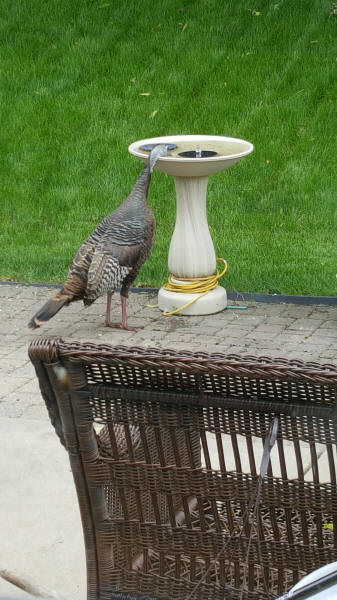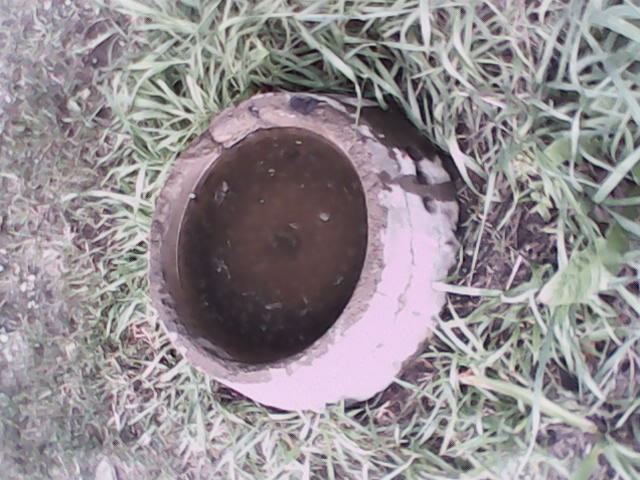As a writer you will observe many things in life differently than others. The better you become at writing, the more differently you will observe. Both people and animals develop habits and you will develop habits which allow you more observations of such. You don’t know it. You won’t admit it until many years later, if at all, but you will develop such habits.
 For decades now we have always had a stone livestock dish outside for our various dogs. It would change locations from time to time, but, it was always there and one of us always kept it filled for them. Whenever I was home I would rinse and fill it multiple times per day during the really hot days. Kind of pointless with our later dogs since they always wanted in where the air conditioning was, but our earlier dogs wouldn’t even think about coming in until it was pushing triple digits. I don’t know why. They just found places in the shade where they could keep an eye on things and chose to stay out.
For decades now we have always had a stone livestock dish outside for our various dogs. It would change locations from time to time, but, it was always there and one of us always kept it filled for them. Whenever I was home I would rinse and fill it multiple times per day during the really hot days. Kind of pointless with our later dogs since they always wanted in where the air conditioning was, but our earlier dogs wouldn’t even think about coming in until it was pushing triple digits. I don’t know why. They just found places in the shade where they could keep an eye on things and chose to stay out.
 Growing up on a farm doesn’t make me completely naive. I’m well aware birds, squirrels, rabbits and other creatures were all using this dish, especially when it was moved farther from the house where they could approach it in secret. Even after the last dog was gone I kept rinsing and filling the dish multiple times per day. The squirrels seemed to pick up on the fact they weren’t being chased anymore and became more playful in the yard. I even wrote a post about how the robins were keeping me as a pet some time back. Observing their interactions provided some simple pleasure in life.
Growing up on a farm doesn’t make me completely naive. I’m well aware birds, squirrels, rabbits and other creatures were all using this dish, especially when it was moved farther from the house where they could approach it in secret. Even after the last dog was gone I kept rinsing and filling the dish multiple times per day. The squirrels seemed to pick up on the fact they weren’t being chased anymore and became more playful in the yard. I even wrote a post about how the robins were keeping me as a pet some time back. Observing their interactions provided some simple pleasure in life.
 As you can see by the pictures, decades of being outside finally took its toll on the old cement livestock dish. It’s ample cracks could half drain the water within an hour. It was also a bit deep for the ornamental birds. The robins and starlings would belly flop at speed into it, but, unless it was clear full it was no use to the canaries. While there was a regular ornamental bird bath up at the other house, it wasn’t always kept full. Life gets in the way of these things. Honestly, I slipped keeping the stone dish full during the hot days with our last dog because, unless you were outside with him, he was staying in the air conditioning. During hot days he was never out for more than a few minutes at a time when he absolutely had to be. Getting a canary friendly water dish which could also contain enough water for a dog’s quick drink, when I finally bring myself to get another one, became the defining criteria for a replacement stone dish. I mean these pretty blue things started showing up.
As you can see by the pictures, decades of being outside finally took its toll on the old cement livestock dish. It’s ample cracks could half drain the water within an hour. It was also a bit deep for the ornamental birds. The robins and starlings would belly flop at speed into it, but, unless it was clear full it was no use to the canaries. While there was a regular ornamental bird bath up at the other house, it wasn’t always kept full. Life gets in the way of these things. Honestly, I slipped keeping the stone dish full during the hot days with our last dog because, unless you were outside with him, he was staying in the air conditioning. During hot days he was never out for more than a few minutes at a time when he absolutely had to be. Getting a canary friendly water dish which could also contain enough water for a dog’s quick drink, when I finally bring myself to get another one, became the defining criteria for a replacement stone dish. I mean these pretty blue things started showing up.
 You also never know, during the dog days of August, when a turkey will get thirsty. Why have a water source only tall turkeys can drink out of?
You also never know, during the dog days of August, when a turkey will get thirsty. Why have a water source only tall turkeys can drink out of?
Admittedly, during the really hot parts of the year, I would slip when it came to refilling that leaking old dish. I mean, Bud was pretty much only following me from office to house and back. He had all kinds of water in both places. His longest venture out of doors was the nightly walk I took him on along the pine trees and as soon as he “read the paper,” he was racing back to the house and its air conditioning.
There was one trip a few years ago when I was heading in for lunch with Bud. I walked past the stone dish and saw it was empty. I said to myself “I’ll fill it on the way back.” I had filled it early in the morning, but it was bone dry now. We didn’t get 15 feet from the dish when we both heard this THUD behind us. We both turned to look and saw a urkey Vulture had planted itself right by the livestock dish. It looked in the bowl. It looked at me. It looked at the bowl again and flew away.
“ALRIGHT! I’ll fill it!” I said as I walked back to the hydrant.
-1.jpg&f=1) Honestly, can there be a creature more ugly _and_ necessary than a Turkey Vulture? Without them road kill wouldn’t go away.
Honestly, can there be a creature more ugly _and_ necessary than a Turkey Vulture? Without them road kill wouldn’t go away.
 I did some calling around and found a local place with some odds and ends which had been outside a while. They were all solid and I wasn’t buying it to be decorative. The image really doesn’t do it justice. I can barely pick the thing up. It holds several gallon of water. All of the pretty birds like that little rise in the center and the robins still belly flop.
I did some calling around and found a local place with some odds and ends which had been outside a while. They were all solid and I wasn’t buying it to be decorative. The image really doesn’t do it justice. I can barely pick the thing up. It holds several gallon of water. All of the pretty birds like that little rise in the center and the robins still belly flop.
Given the lower height of this water dish, the squirrels have been making much more frequent trips to it. They appear shocked when I step out of my office and go scampering up the nearest tree. They have been much freer with their play time in the yard lately now that Bud’s not chasing them. Honestly, squirrels entertain me.
 One thing city dwellers don’t realize is that from mid July until harvest starts, game is scarce for birds of prey. The corn is tall. The soybeans are usually butt high and bushy. For the meat eating birds, this is a hard time. They have to strike other birds mid air or starve to death if they wish to stay away from dwellings. Birds of prey dread this time of year in Illinois and so do free range chicken farmers. The rest of the year birds of prey tend to stay away from chicken. It’s not difficult to imagine, despite their protected status, that more than one gets offed when they start feasting on the chickens. The older, larger birds of prey start hanging around homesteads with water, because they need it too, and taking their chances in that narrow space between the corn field and safety of a tree. Even the field mice don’t venture from a bin or shed during this weather. Their bodies don’t hold enough water to survive 90+ degree heat for long.
One thing city dwellers don’t realize is that from mid July until harvest starts, game is scarce for birds of prey. The corn is tall. The soybeans are usually butt high and bushy. For the meat eating birds, this is a hard time. They have to strike other birds mid air or starve to death if they wish to stay away from dwellings. Birds of prey dread this time of year in Illinois and so do free range chicken farmers. The rest of the year birds of prey tend to stay away from chicken. It’s not difficult to imagine, despite their protected status, that more than one gets offed when they start feasting on the chickens. The older, larger birds of prey start hanging around homesteads with water, because they need it too, and taking their chances in that narrow space between the corn field and safety of a tree. Even the field mice don’t venture from a bin or shed during this weather. Their bodies don’t hold enough water to survive 90+ degree heat for long.
Given we have a long pine tree wind break, we have a lot of birds and more than a few squirrels. We used to have a rather severe gopher problem in the front pasture. As a child I shot a lot of them and fed them to the barn kitties. In later years you would see the barn kitties out in pasture and road ditch stalking. Some of them really liked gopher. The livestock is long since gone and the barn kitties left not all that many years after we stopped having livestock. Without all of the feed laying around, there just weren’t enough mice to interest them. Oh, they liked the kitty food they got, but, they were barn kitties. They wanted something to hunt, so they left. I ran into them from time to time at various neighbors.
Without livestock, we’ve had to take up the duty of mowing the pasture out front. Without the shelter of random tall grass spots the gophers became exposed. For a few weeks a couple of hawks took up residence in the pine trees. After that, I didn’t really see any gopher.
Hawks and large owls have learned to exist with farmers. During spring tillage and fall harvest you will see them circling you in the field looking for that freshly disoriented mouse or snake. Flocks of black birds will be landing on your fresh pass feasting on worms and bugs, but, only after the hawks and owls have had their fill of mice. It’s nothing to see a couple of hawks or falcons on the ground a few passes away walking over to where you just tilled. These things can live for over 30 years so they learn how things work on a farm. I wouldn’t be surprised to learn they thought we were there to serve them.
 Like many years, we had multiple plantings of sweetcorn along our lane. It’s just a convenient place to plant 8 short rows or so of sweet corn when we happen to have corn in that field. It may be difficult for you to see from the picture, but that dead brown spot before you get to the green short rows farther down is what remains of the first planting. There is always some sweetcorn you don’t pick. Sucker and deformed ears in particular. You always step the stalk over when you have picked the last of what you want from it so it quits consuming water and nutrients. This also lets it start degrading earlier. Over the past few days I’ve seen these piles of white debris in the yard. I hadn’t thought much of it until the other day.
Like many years, we had multiple plantings of sweetcorn along our lane. It’s just a convenient place to plant 8 short rows or so of sweet corn when we happen to have corn in that field. It may be difficult for you to see from the picture, but that dead brown spot before you get to the green short rows farther down is what remains of the first planting. There is always some sweetcorn you don’t pick. Sucker and deformed ears in particular. You always step the stalk over when you have picked the last of what you want from it so it quits consuming water and nutrients. This also lets it start degrading earlier. Over the past few days I’ve seen these piles of white debris in the yard. I hadn’t thought much of it until the other day.


It turns out squirrels don’t like sweetcorn until it becomes dry and hard like field corn. It also turns out they don’t like the soft pithy white center of the cob, everything else it seems they eat. So, once the discarded sweetcorn got old enough to be appetizing for them, they have been schlepping out of the safety of the trees returning with ears to eat.
Last night I walked back to my office after supper to hear the robins just ganging up on something. I mean they were pissed off chirping like a couple of New York cab drivers involved in a wreck! I looked over to the front of my house and saw this massive bird. Honestly, I thought it was a dog at first given the lighting and the size of the thing.
 The Great Horned Owl in the image is not the one I saw. This one must be quite young as it is much smaller. It looked up at me and I waved to it then continued walking to my office. It watched me for a while then went back to eating whatever it had pinned to the ground. Naturally I thought one of the incredibly numerous robins fell victim.
The Great Horned Owl in the image is not the one I saw. This one must be quite young as it is much smaller. It looked up at me and I waved to it then continued walking to my office. It watched me for a while then went back to eating whatever it had pinned to the ground. Naturally I thought one of the incredibly numerous robins fell victim.
Some time later I finished writing for the evening and started to walk back to the house. I heard the most pitiful sound. Over the years at various times I had heard similar pitiful sounds coming from the pine trees. Tonight it was from a tree in my yard. Wailing and not trying to hide it. I walked over to see a squirrel in mourning. No, I didn’t take a picture. There are some things you should never photograph.
One of the squirrels who had been frolicking in my yard all summer, didn’t make it back from the sweetcorn patch. It appears the robins and the squirrels had well known hawk and falcon signals for each other, but the owl signals hadn’t been fully implemented yet. It makes sense the squirrels and robins would cooperate. They aren’t enemies and for much of the year they don’t even eat the same food. What was surprising was just how close they would get to an owl, pecking their displeasure at it over a squirrel.
Today the squirrels have been in hiding. I haven’t even seen the robins at the water dish. Just the starlings which the owls couldn’t possibly eat enough of. Where do they find a mulberry tree bearing fruit in August? The high yield blue ordinance has been widely distributed lately.




